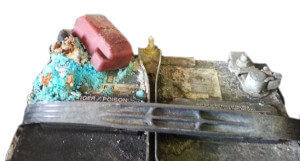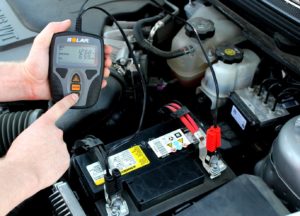Prevent a dead car battery in winter
How to prevent a dead car battery in winter
Dead car battery Rule #1
Clean the battery terminals
Corrosion on your battery terminals is a major cause of a dead car battery in winter weather. Corrosion increases electrical resistance which means your alternator has a harder time recharging your battery. The corrosion also reduces the amount of power available to crank the engine.

Look at the corrosion on these battery cables. And you wonder why it won’t start?
What color is the battery corrosion?
The color of the corrosion on the battery terminals can give you an idea of the battery’s condition. White powdery buildup on the negative battery terminal is a sign of battery sulfation, which means your battery is most likely discharged. If you see that white powder, you can bet you’re going to have reduced starting power.
Blue/green corrosion is copper sulfide which results in high electrical resistance. That greatly reduces the amount of power from the battery to the starter motor. It’s caused by leaking battery acid between the case and the battery post. If you clean off the corrosion and it returns right away, replace the battery.
In other words, any corrosion on the battery terminals is a sign of pending starting problems and the eventual dead battery.
See this post on how to clean battery terminals.
Dead car battery Rule #2
Test your battery’s health
Modern battery testers test more than just  amperage capacity. They also test internal resistance and conductance which is a sign of overall battery health. Typical battery life is 3-4 years. So testing your battery can give you a heads up of an impending dead car battery long before it leaves you stranded.
amperage capacity. They also test internal resistance and conductance which is a sign of overall battery health. Typical battery life is 3-4 years. So testing your battery can give you a heads up of an impending dead car battery long before it leaves you stranded.
Dead car battery Rule #3
Keep your battery charged
Keep your battery charged, especially if you do short drives in winter
Short trips in cold weather are a major battery killer. Here’s why. You start your engine in frigid winter temperatures. Since your battery generates electricity through a chemical reaction and that reaction slows at colder temperatures, you have less power available. At the same time, you’re trying to rotate a mechanical engine when the oil has thickened due to the cold. So the starter needs more power at a time when the battery has less output. In other words, your battery will need recharging the instant your engine fires up. No problem you say? Wrong. Wrong. Wrong.
Because the instant you start your car in cold weather, you immediately crank up the blower motor, rear window defogger, and heated seats. If it’s dark outside, you also turn on your headlights. At that point, you’re drawing almost 90-amps out of the battery. At idle speed your alternator can only output about 1/3rd of its capacity, so you’re immediately discharging your battery. If you drive a short distance and shut off your engine, you’ll be leaving it in a deficit condition. Do this often and you’ll dramatically reduce battery life. What’s the answer? Use a battery charger or battery maintainer to bring it back to full health.
See this post on battery chargers and maintainers.
Dead car battery Rule #4
Use it or lose it
Lead acid batteries self discharge at about 1% per day in cold weather. That’s with no load applied. Unfortunately, all modern vehicles draw a constant load of around 50-milliamps when the car isn’t running. That’s the power needed to run the anti-theft alarm, remote keyless entry modules and to maintain keep alive memory. Put all that power drain together and you’re looking at a dead car battery after about 30-days with no driving.
If you don’t drive your car often, use a battery maintainer or battery charger to keep your battery healthy.
Dead car battery Rule #5
Use a jumper pack instead of jumper cables
I know you’ve used jumper cables for your entire driving career. And I know you know how to use them. But cars have changed. A modern vehicle can have up to a dozen computers and they’re all very sensitive to voltage spikes; the kind that are produced when you connect jumper cables.
When you make the final connection or disconnection from a running donor vehicle, the voltage spike can be high enough to damage a computer module. That doesn’t happen if you jump start with a jumper pack because the jumping voltage is never more 12.7-volts. Jumping with a jumper pack is much safer than the same jump with jumper cables.
See this post on how to buy a jumper pack
©, 2019 Rick Muscoplat
Posted on by Rick Muscoplat